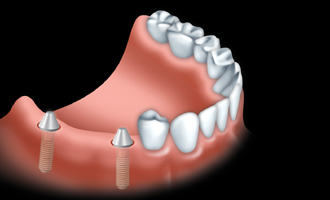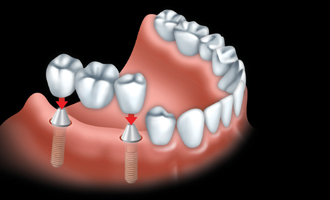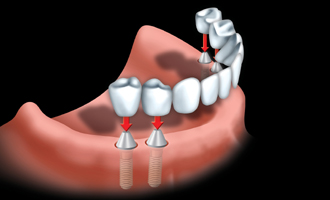Bridges & Dentures – Victoria Dentists
The best teeth are your own natural teeth. But sometimes, a tooth is badly damaged or lost. If a tooth is lost, it is important to replace it with an artificial tooth as soon as possible. This will prevent the teeth that are left from drifting out of line and possibly causing jaw problems. Teeth that are out of line are harder to clean and are more likely to get periodontal disease (gum disease) and cavities. If one or more of your teeth are missing, your dentist may suggest replacing your missing teeth with a bridge or a denture. If you need to have a tooth (or teeth) replaced, your dentist may do it, or he or she may refer you to a prosthodontist. A prosthodontist is a dentist who has completed a university post-graduate specialty program in prosthodontics. Prosthodontics is a specialty of dentistry that deals with restoring and replacing natural teeth and tissues with artificial substitutes.
Bridges
A bridge—also called a “fixed bridge” or a “fixed dental prosthesis,” is a dental restoration that replaces one or more missing teeth. It extends across an area that has no teeth and is typically made up of an artificial tooth fused between 2 crowns. (A crown is a hollow, artificial tooth that fits over a natural tooth or a dental implant). The bridge is held firmly in place by your own teeth on each side of the missing one(s) or by dental implants. A bridge is permanent and cannot be removed.
How a Bridge is Done
- If you have healthy teeth on each side of a missing tooth (or teeth), your dentist files down the 2 healthy teeth to prepare them for the bridge. If you don’t have healthy teeth or enough teeth to support a bridge, then dental implants may be surgically placed. A dental implant is an artificial root made of titanium metal that is inserted into the jawbone to replace the root of the natural tooth. The implant acts as an anchor to hold an artificial tooth or bridge in place.
- Next, your dentist makes a model of your teeth by taking impressions (molds). The model is used to custom-make the artificial tooth (or teeth) and 2 crowns as one piece. This piece is called a bridge.
- Meanwhile, your dentist places a temporary bridge in your mouth to protect the exposed teeth and gums.
- During your second visit, your dentist removes the temporary bridge and places the custom-made bridge in your mouth. The crowns are either cemented to your 2 healthy teeth or attached to your dental implants on each side of the missing tooth (or teeth).
Types of Bridges
There are different types of dental bridges. Your dentist or prosthodontist will recommend the most appropriate one depending on the location of the missing tooth (or teeth) and the condition of your teeth, mouth and gums.
Traditional bridges are used if there are natural teeth on each side of the gap where the tooth is missing. (As an alternative to a bridge, your dentist may suggest a single implant to replace a missing tooth between 2 healthy teeth. An implant will prevent you from having to get your healthy teeth filed down in preparation for the crowns.)
Implant Bridges
Implant bridges are used if you don’t have healthy teeth or enough teeth to support a bridge, or when several or all teeth are missing. A custom-made bridge is anchored to the dental implants. Your dentist will first determine if dental implants are right for you.
Resin-bonded bridges
Resin-bonded bridges, also known as “Maryland” bridges, are used when the missing teeth are in the front of the mouth. This type of bridge involves the artificial teeth being fused together to metal bands and cemented to the back of your natural teeth.
Cantilever bridges
Cantilever bridges are used when there are healthy teeth on only one side of the missing tooth or teeth. This procedure involves anchoring the artificial tooth over one or more of your natural adjacent teeth.
Caring for Your Bridge
If you take good care of your bridge, it should generally last for about 10 years, or perhaps longer. Like natural teeth, bridges need to be brushed and flossed every day. Your dentist will show you how to use a floss threader to floss under and around the artificial tooth (or teeth) in the middle of the bridge. Regular dental visits and professional cleanings are also important. If you have an implant bridge, your dentist will show you how to properly care for them.
Dentures
Dentures are artificial replacements for your natural teeth and gums. If an accident, a disease or poor oral health care has left you with only a few healthy teeth or none at all, your dentist or prosthodontist might suggest dentures to replace your missing teeth. There are 2 types of dentures: partial and complete. For both types of dentures your dentist or specialist makes a model of your teeth by taking impressions. The models are used to custom-make your dentures.
Types of Dentures
Partial dentures are also called “removable partial denture prostheses” or “partials.” They may be used when nearby teeth are not strong enough to hold a bridge, or when more than just a few teeth are missing. Partial dentures are made up of one or more artificial teeth held in place by clasps that fit onto nearby natural teeth. You can take the partial denture out yourself, for cleaning and at night.
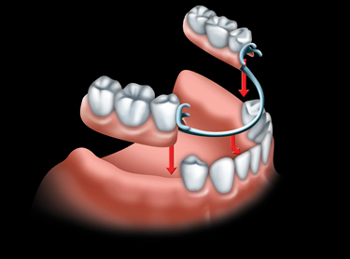
A partial denture
Complete dentures are what we most often refer to as “false teeth.” They are also called “full dentures” and are used when all your natural teeth are missing. Complete dentures are removable as they are held in place by suction. They can cause soreness at first and take some time to get used to. There are 2 types of complete dentures: immediate dentures and conventional dentures.
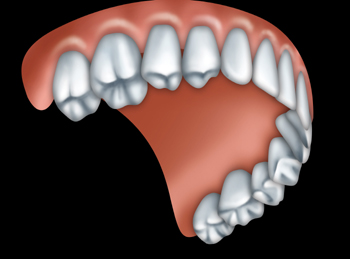
A full upper denture
Immediate dentures are made before your teeth are removed. Your dentist takes measurements and makes models of your jaws during your first visit. Once your teeth are extracted, your dentist inserts the immediate dentures. The benefit of immediate dentures is that you are not without teeth during the healing period, which can take up to 6 months. During the healing period, your bones and gums can shrink and your immediate dentures may need to be relined by your dentist for a proper fit.
Conventional dentures are made and inserted into your mouth after your teeth have been extracted and the gums and jaw tissues have healed.
Overdentures
If you are having trouble with your complete dentures, your dentist may suggest overdentures. An overdenture is a removable denture that fits over the natural teeth left in your mouth or over dental implants. If you have some natural teeth left, they are reshaped to fit in the denture. If there are no natural teeth left, small implants are placed into the jawbone. The overdenture attaches to the implants or rests on the natural teeth.
Caring for Your Dentures
Complete and partial dentures need to be cleaned every day just like natural teeth. Otherwise, plaque and tartar can build up on your dentures and cause stains, bad breath and gum problems. Plaque from your dentures can also spread to your natural teeth and gums, causing gum disease and cavities.
To clean your dentures, remove them from your mouth and run them under water to rinse off any loose food particles. Then wet a denture brush or a regular soft-bristle toothbrush and apply denture cleaner or a mild soap. Household cleaners and regular toothpaste are too abrasive and should not be used for cleaning dentures. Gently brush all surfaces of the dentures including under the clasps where bacteria collect. Be careful not to damage the plastic or bend the attachments. Rinse your dentures well in clean water before placing them back in your mouth.
While your dentures are removed, be sure to clean and massage your gums. If your toothbrush hurts your gums, run it under warm water to make it softer or try using a finger wrapped in a clean, damp cloth. If you have partial dentures, brush your natural teeth with a soft-bristled toothbrush and floss.
Always remove your dentures overnight to give your mouth a chance to rest. Soak them in warm water with or without denture cleanser. If your dentures have metal clasps, only use warm water for soaking, as other soaking solutions can tarnish the metal. When you’re not wearing your dentures, keep them in water to stop them from drying out or warping. Never use hot water for soaking.
Dentures can break if dropped or squeezed too tightly. When you are handling your dentures, stand over a folded towel or a sink of water just in case you accidentally drop them.
Look for cracks in your dentures. If you find any, take them to your dentist or specialist for repair. See your dentist regularly and at least once a year. Your mouth is always changing, so your dentures will need adjusting or relining from time to time to make sure they fit well. Poorly fitted dentures may cause denture sores that make oral cancer more difficult to spot. At your dental exam, your dentist will also examine your gums for any signs of disease or oral cancer and any natural teeth you may have for signs of decay or infection.




